The Armata Festival and the Allure of Spetses...
Experience Spetses in its most enchanting...
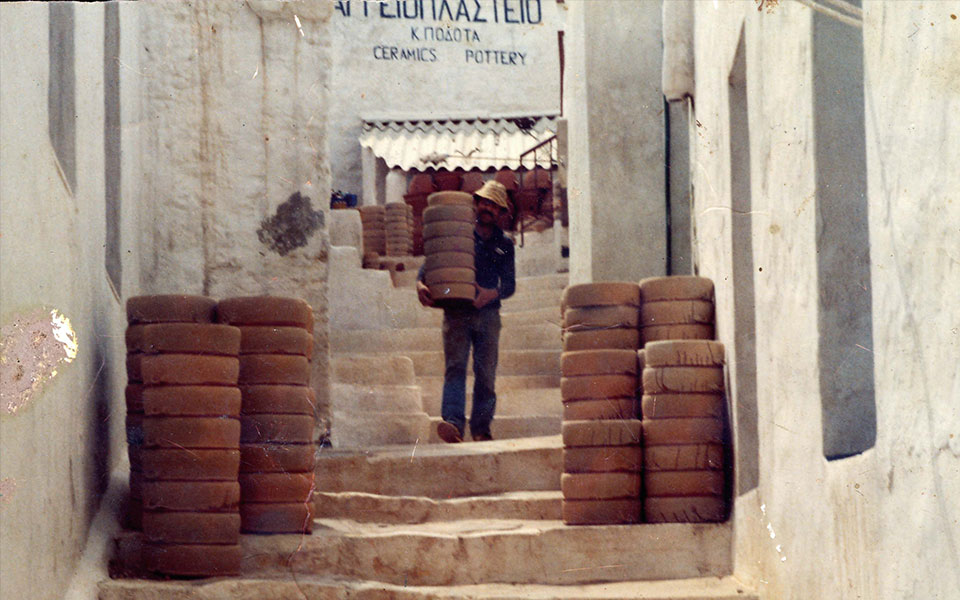
Kostas Podotas at his Kamares workshop, c. 1985. Podotas Pottery.
Founded in 2019, Archipelago Network (AN) is a Greece-based organization dedicated to promoting and safeguarding the natural environment and traditional lifeways of the Cyclades. Situated at the confluence of Europe, Africa, and Asia, these remarkable islands are not only biodiversity hotspots but also repositories of diasporic culture and traditional knowledge, whose communities are under increasing threat from over-tourism and the global climate crisis.
Responding to these formidable challenges, Archipelago Network is transforming the Cyclades into dynamic island laboratories for research, bringing together scholars, artists, and local communities in a series of thematic projects and public programs. Through this collaborative approach, AN integrates visual practices with cultural and environmental studies, making its digital collections widely accessible and fostering regional memory through documentation and outreach.
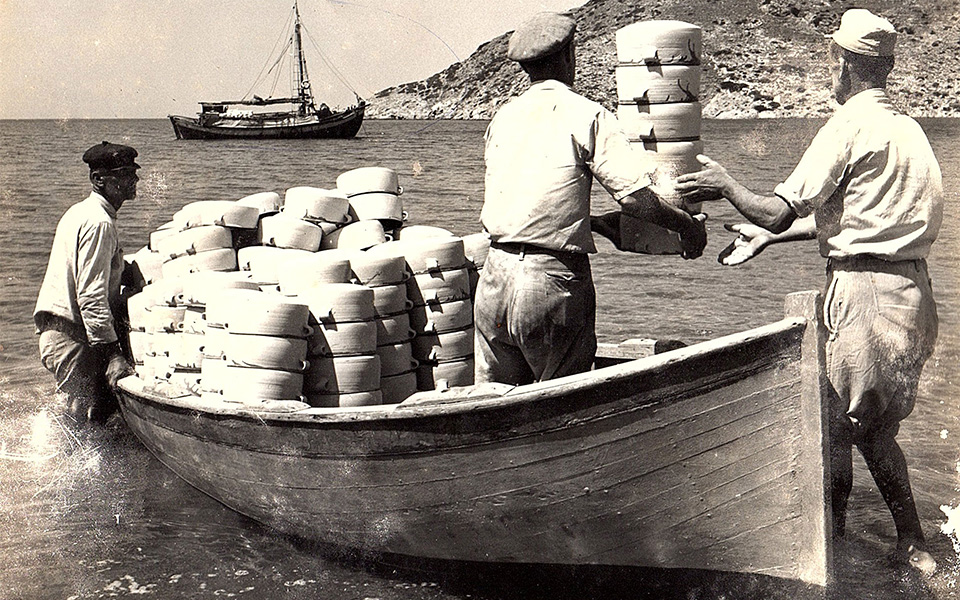
Loading cookware onto trading caique in Vathy, c. 1965. Atsonios Pottery, Sifnos.
Past projects such as “Maritime Trades of the Cyclades,” “Boatbuilding on Syros Today,” and “Anthemis” have highlighted various aspects of island life, from traditional boatbuilding and small-scale fishing to indigenous flora, local culinary traditions, and music. This work not only preserves local heritage but also initiates transnational collaborations, enriching cultural and artistic discourse across the wider Mediterranean.
For a recent project, AN turned its attention to the pottery of Sifnos, an island renowned for its unique ceramics and centuries-old pottery-making tradition. “Our engagement with Sifnos began when we were approached by local community members involved in the effort to start a museum for pottery on the island,” AN founder and lead researcher Jacob Moe told Kathimerini in June 2023.
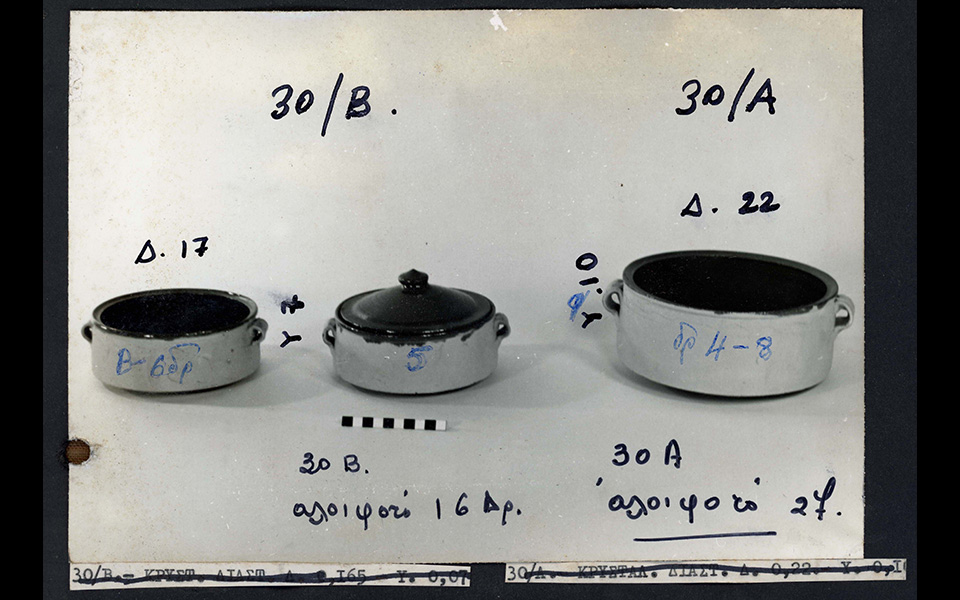
EOMMEX pottery catalog of Simeon Apostolidis, c. 1970. Apostolidis Pottery.
© Archipelago Network
In close collaboration with the Sifnos Potters’ Union, the working group for the Sifnos Pottery Museum, the estate of postwar artist and architect Cosmas Xenakis (1925-1984), and other regional archives, over the past year, AN has created an extensive digital and audio-visual record of the island’s artisans. “Pottery is closely linked with the island’s culture and economy and is a successful example of the coexistence of traditional culture and tourism,” Moe says.
Featuring newly digitized materials, including photographs, handwritten documents, films, and musical recordings, the project has also produced thirteen video portraits presenting a panorama of the history and current activity of the island’s workshops. By recording the stories and practices of Sifnos’ potters, detailing traditional techniques that have been passed down through the generations, AN seeks to ensure the continuity of this vibrant craft and its cultural legacy.
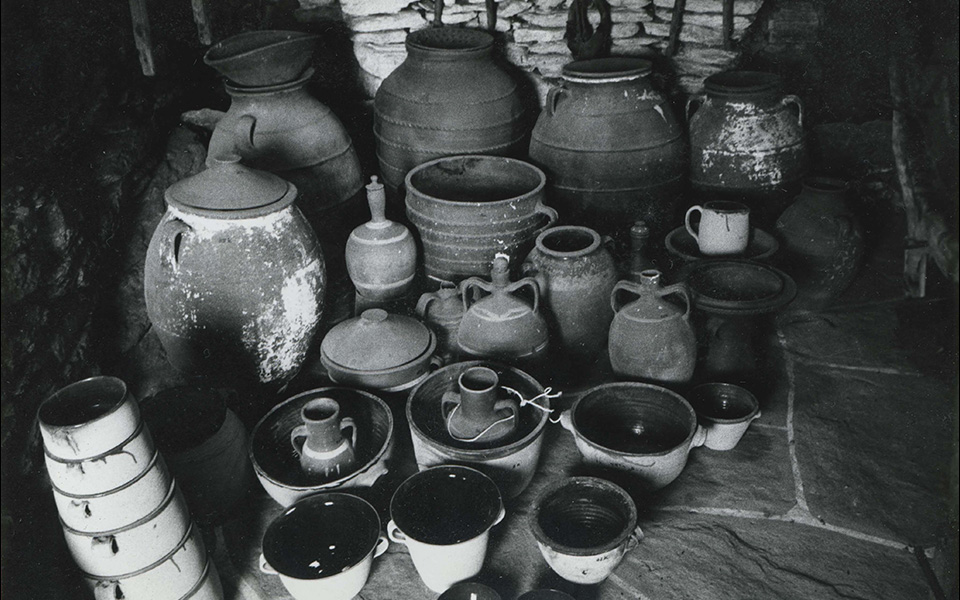
Cosmas Xenakis’s Crafts Collection
A recent screening, hosted in the garden of the British School at Athens (BSA) on June 11, showcased three of these video portraits. Each film was followed by an engaging discussion led by three experts on ancient and modern ceramics. Rebecca Sweetman and Evangelia Kiriatzi from the BSA, along with Toby Brundin from the Craft Potters Association in the UK, explored themes of mobility, island resilience, and the interplay between tradition and innovation. Their responses to the films highlighted the enduring significance of the past.
A central theme emerged from the films and discussions: the connection between ancient and modern practices. It underscored how ancient craft techniques are not only mirrored but also motivate contemporary artists. It highlighted the role of archaeology in understanding and responding to current issues of mobility and migration. Additionally, the dialogue emphasized how blending traditional and modern methods can spur technological advancements and cultural transformations.
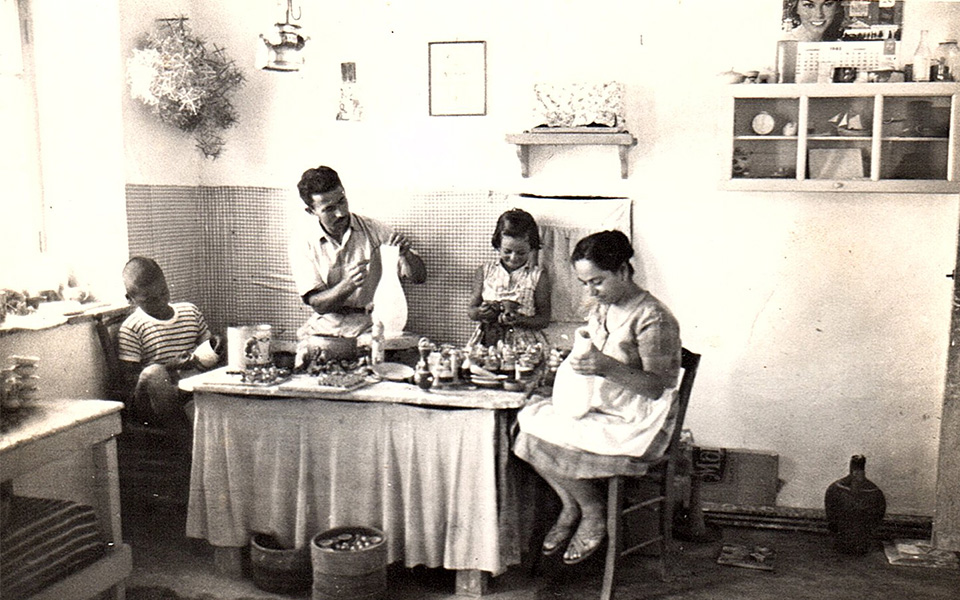
The Kalogirou family painting ceramics in their Kamares workshop, c. 1959.
The British School at Athens (BSA) is one of 19 foreign research institutions in Greece, dedicated to advancing the study of Greek lands in the broadest sense. With nearly 140 years of research, the BSA aims to share its findings and knowledge with the wider public. Since 1974, the Fitch Laboratory for Archaeological Science, part of the BSA, has been at the forefront of applying scientific techniques to archaeological research in Greece. Its work primarily focuses on investigating archaeological ceramics, exploring questions about their origins and creators, and using this information to study mobility, identity, and technology. This collaborative event demonstrated the BSA and Fitch’s mission, by fostering connections with contemporary craftspeople and engaging in meaningful conversations. These efforts have enriched our understanding of the past and present while also looking to the future.
Speaking after the event, Rebecca Sweetman, Director of the BSA, said: “The evening’s collaboration with Archipelago Network was a wonderful opportunity to bring many interested people together researchers, archaeologists, artists, potters, islanders and many others to share the work with a hugely enthusiastic audience.”
“It has been an honour and also a fantastic opportunity to combine our work and experience on ancient and contemporary pots and potters in Greece with the exemplary work of Archipelago Network in order to underline the need not just to preserve and widely share the huge cultural legacy of pottery making in Greece but also to support its flourishing future,” added Evangelia Kiriatzi, Director of the Fitch Laboratory, BSA.
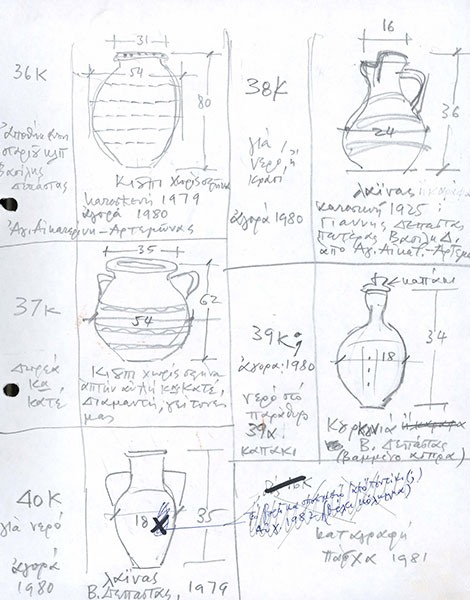
Page from Cosmas Xenakis’s Notebook
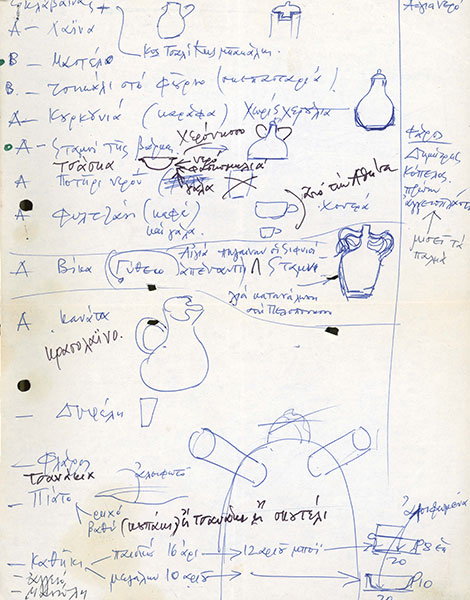
Page from Cosmas Xenakis’s Notebook
Pottery making has been practiced on Sifnos since at least 18th century (although more research is required to shed light on the assumingly long history of the craft on the island) embedding itself into the island’s cultural identity. The craft flourished due to the island’s favorable environmental conditions and natural resources: an abundance of refractory clay from schist rock, ample freshwater from springs, suitable wood for fuel, and a mild Mediterranean climate. These elements, combined with the exceptional skill of Sifnian potters, have sustained the tradition through countless generations. Indeed, the term “Sifnian” became synonymous with master potters, whether they were “tsikalas” (cooking pot makers), “aggeioplastis” (pot-makers), or “kanatas” (pitcher makers).
Historically, the location of Sifnian pottery workshops was influenced by the ever-present threat of piracy in the Ottoman eastern Mediterranean. Initially, potteries were established inland to meet local needs safely. However, after the establishment of the Greek State in the early 19th century, which brought increased security, potters moved their workshops to coastal areas, close to sheltered bays for easy transportation and trade beyond the island.
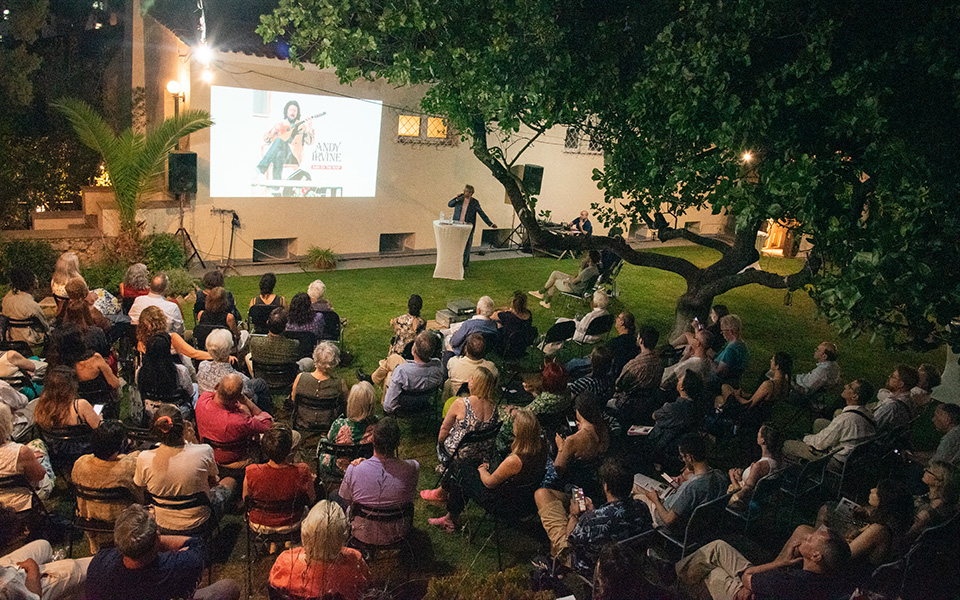
At the peak of the industry, Sifnian pottery workshops had a well-defined division of labor, including roles such as the “kladas” (wood gatherer), “homatas” (clay collector), “moularas” (clay transporter), “kopanistis” (clay preparer), and the master potter with his assistant (“pasperetis”). Renowned for its high quality and distinctive artistic style, the influence of Sifnian potters extended beyond the island, with many migrating to other Cycladic islands and regions of mainland Greece, most notably in Attica (Maroussi, Halandri, and Agia Paraskevi), as well as abroad, contributing to the spread of their craft.
Today, there are fifteen active workshops on the island, producing both traditional household items for cooking and storage and contemporary ceramics. Distinctive Sifnian pottery includes the “mastelo” (a large baking dish for preparing the traditional meat dish of the same name in wood-burning ovens), the “tsikali” (cooking pot), various jugs, braziers, “kouroupi” (storage pot), jars, and “armeos” (vessel for milking). Most iconic, however, is the “flaros” (clay chimney). In addition to these traditional items, Sifnian potters also create decorative objects and continually experiment with new forms and colors, blending innovation with their rich heritage.
Archipelago Network’s project paints a comprehensive picture of Sifnos’ age-old pottery tradition. The archival materials reveal the technical and symbolic knowledge accumulated over generations, showcasing everything from clay preparation techniques to the social and cultural lives of the potters and their families. Noteworthy pieces include historic photographs of workshops, color recipes from the 1960s, and super 8 films documenting the daily activities of potters.
Antonis & Giannis Atsonios | Pottery of Sifnos from Archipelago Network on Vimeo.
As mentioned, a key component of the project is a series of thirteen video portraits that profile the current activity of active pottery workshops on Sifnos. These portraits interweave observational footage, archival materials, and interviews, providing a vivid portrayal of the multigenerational history of the island’s pottery craft. The video series not only documents the technical processes involved in pottery making but also captures the personal stories and cultural significance of this enduring tradition. Featured potters include Giannis Apostolidis, Giannis and Antonis Atsonios, and Nikos and Giannis Lembesis, among others.
Giannis Apostolidis | Pottery of Sifnos from Archipelago Network on Vimeo.
Cosmas Xenakis, an artist and architect, made significant contributions to the preservation of Sifnian pottery. His Crafts Collection, compiled during the 1960s when functional ceramics were declining due to the introduction of new materials and changes in consumer demand, consists of cookware and tools donated by local workshops. This collection, slated to become a core element of the in-development Sifnos Pottery Museum, provides invaluable material evidence of the island’s pottery production during a pivotal era, before the rise of mass tourism in Greece. Xenakis meticulously documented his collection, creating a system that categorized items by their use and origin, thus preserving the historical testimony of this cultural tradition.
Nikos & Giannis Lembesis | Pottery of Sifnos from Archipelago Network on Vimeo.
The project on the pottery of Sifnos is further enriched by ongoing interdisciplinary research conducted in collaboration with curator Lydia Matthews (Parsons Fine Arts Program) and architectural historian Ioanna Theocharopoulou (Cornell University). Matthews’ research concerns the interaction between traditional craft and contemporary artistic practice through the lens of two long-term collaborations between visual artist Zoe Keramea and the Atsonios pottery on the one hand, and visual artist Diane Katsiaficas and the Lembesis pottery on the other. Theocharopoulou’s research deploys the Xenakis collection of artifacts as objects that illuminate local intersections of landscape, built environment, and craft. Both will be published as essays on AN’s website, while also providing theoretical and practical approaches to be integrated into the Sifnos Pottery Museum’s exhibition design in the longer term.
Through this comprehensive project, Archipelago Network not only preserves the historical and cultural legacy of Sifnos’ pottery but also ensures its continuity and relevance in the present day. By engaging with the island’s past and present potters, AN fosters a deeper appreciation of this vibrant craft and its enduring impact on the island’s unique cultural identity.
Archipelago Network makes these findings widely accessible through an open-access archive on their bilingual (Greek and English) website, as well as a forthcoming series of public events in Sifnos aimed at building capacity for the Sifnos Pottery Museum as a hub for education, research and training related to traditional pottery of the Aegean.
For additional information on this and other Archipelago Network projects, please visit archipelagonetwork.org.
Experience Spetses in its most enchanting...
Landmark shops, a lively cultural scene...
From kafeneia serving souma and meze...
The attention of the global fishing...